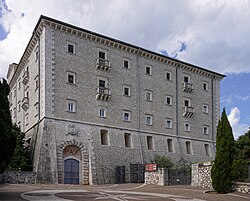
Back مونتيكاسينو Arabic جبل مونتيكاسينو ARZ Monte Cassino Catalan Μόντε Κασίνο Greek Monto Kasino Esperanto Monte Cassino Spanish Montecassino Estonian Montecassino Basque صومعه بندیکتین Persian Montecassino Finnish
 Abbey of Monte Cassino | |
| Monastery information | |
|---|---|
| Order | Benedictine |
| Established | AD 529 |
| Diocese | Diocese of Monte Cassino |
| People | |
| Founder(s) | Benedict of Nursia |
| Abbot | Antonio Luca Fallica OSB |
| Site | |
| Location | Cassino, Italy |
| Coordinates | 41°29′24″N 13°48′50″E / 41.49000°N 13.81389°E |
| Public access | Yes |
Monte Cassino (today usually spelled Montecassino) is a rocky hill about 130 kilometres (80 mi) southeast of Rome, in the Latin Valley, Italy, 2 kilometres (1+1⁄4 mi) west of Cassino and at an elevation of 520 m (1,710 ft). Site of the Roman town of Casinum, it is widely known for its abbey, the first house of the Benedictine Order, having been established by Benedict of Nursia himself around 529. It was for the community of Monte Cassino that the Rule of Saint Benedict was composed.
The first monastery on Monte Cassino was sacked by the invading Lombards around 570 and abandoned. Of the first monastery almost nothing is known. The second monastery was established by Petronax of Brescia around 718, at the suggestion of Pope Gregory II and with the support of the Lombard Duke Romuald II of Benevento. It was directly subject to the pope and many monasteries in Italy were under its authority. In 883, the monastery was sacked by Saracens and abandoned again. The community of monks resided first at Teano and then from 914 at Capua before the monastery was rebuilt in 949. During the period of exile, the Cluniac Reforms were introduced into the community.
The 11th and 12th centuries were the abbey's golden age. It acquired a large secular territory around Monte Cassino, the so-called Terra Sancti Benedicti ("Land of Saint Benedict"), which it heavily fortified with castles. It maintained good relations with the Eastern Church, even receiving patronage from Byzantine emperors. It encouraged fine art and craftsmanship by employing Byzantine artisans. In 1057, Pope Victor II recognised the abbot of Monte Cassino as having precedence over all other abbots. Many monks rose to become bishops and cardinals, and three popes were drawn from the abbey: Stephen IX (1057–58), Victor III (1086–87) and Gelasius II (1118–19). During this period, a monastic chronicle, Chronica sacri monasterii casinensis, was written by two of its own, Cardinal Leo of Ostia and Peter the Deacon (who also compiled the cartulary).
By the 13th century, the monastery's decline had set in. In 1239, the Emperor Frederick II garrisoned troops in it during his war with the Papacy. In 1322, Pope John XXII elevated the abbey into a bishopric but this was suppressed in 1367. The buildings were destroyed by an earthquake in 1349, and in 1369 Pope Urban V demanded a contribution from all Benedictine monasteries to fund the rebuilding. In 1454, the abbey was placed in commendam and in 1504 was made subject to the Abbey of Santa Giustina in Padua.
In 1799, Monte Cassino was sacked again by French troops during the French Revolutionary Wars. The abbey was dissolved by the Italian government in 1866. The building became a national monument with the monks as custodians of its treasures. In 1944, during World War II, it was the site of the Battle of Monte Cassino, when the building was destroyed by Allied bombing. It was rebuilt after the war.
After the reforms of the Second Vatican Council the monastery was one of the few remaining territorial abbeys within the Catholic Church. On 23 October 2014, Pope Francis applied the norms of the motu proprio Ecclesia Catholica of Paul VI (1976)[1] to the abbey, removing from its jurisdiction all 53 parishes and reducing its spiritual jurisdiction to the abbey itself — while retaining its status as a territorial abbey. The former territory of the Abbey, except the land on which the abbey church and monastery sit, was transferred to the diocese of Sora-Cassino-Aquino-Pontecorvo.[2][3] Pope Francis at the same time appointed Father Donato Ogliari as the new Abbot who will serve as the 192nd successor of Saint Benedict.[4] As of 2015, the monastic community consists of 13 monks.[5] Ogliari was succeeded as abbot by Antonio Luca Fallica in 2023.[6]
- ^ "Catholica Ecclesia". Holy See.
- ^ "Vatican announces reorganisation of Montecassino Abbey". Vatican Radio. 23 October 2014.
- ^ "Vatican reorganizes Montecassino, mother abbey of the Benedictines". Catholic News Agency. 24 October 2014.
- ^ Pittiglio, Elena (23 October 2014). "Dom Ogliari nuovo abate di Montecassino" [Dom Ogliari is the new Abbot of Montecassino]. Il Messaggero (in Italian). Rome, Italy. Retrieved 13 February 2021.
- ^ Catalogus Monasteriorum O.S.B. (SS. Patriarchae Benedicti Familiae Confoederatae: Curia dell'Abate Primate, Editio XXII 2015).
- ^ "Resignations and Appointments". press.vatican.va. Retrieved 1 June 2024.
